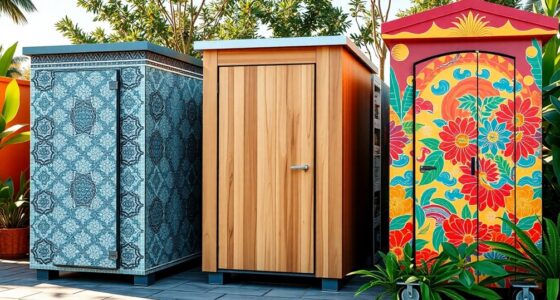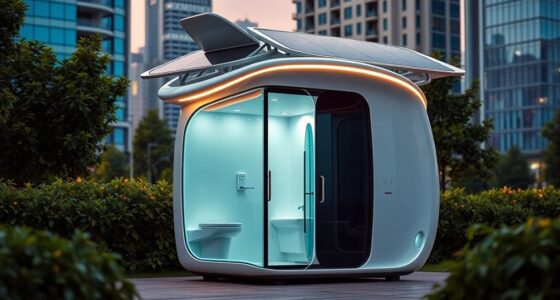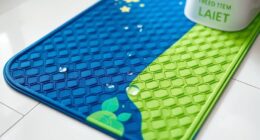New composite materials are transforming portable restroom design by enhancing durability, comfort, and hygiene. These innovations use fiberglass-reinforced plastics and eco-friendly options, making units lighter and easier to transport while providing superior weather resistance. You'll find that advanced features like touchless operations and improved ventilation greatly boost user satisfaction. As the industry continues to evolve, you'll discover even more exciting developments in portable restroom technology that could reshape your expectations.
Key Takeaways
- New composites like fiberglass-reinforced plastics enhance durability and weather resistance, extending portable restroom lifespans by up to 50%.
- Lightweight materials improve transportation efficiency, reducing logistics costs and enabling easier maneuverability on construction sites and events.
- Sustainable materials, including recycled plastics, promote eco-friendly practices and support sustainability goals in portable restroom design.
- Antimicrobial coatings and touchless features enhance hygiene, reducing surface contact and the spread of germs in sanitation facilities.
- Customizable layouts and advanced technology drive innovation, allowing portable restrooms to adapt to diverse user needs and improve overall functionality.
The Evolution of Portable Restroom Materials

As portable restrooms have evolved, so too have the materials used in their construction. Early models were made from basic plastic, which didn't offer much in durability or aesthetics.
Today's modern portable toilets incorporate durable materials, like fiberglass-reinforced plastics, enhancing structural integrity and longevity. These lightweight materials make them easier to transport without sacrificing usability.
Eco-friendly materials, including recycled plastics and biodegradable composites, have become standard, reflecting a commitment to sustainability. Innovations in these materials also improve insulation properties, leading to better climate control.
This means you can enjoy greater user comfort, regardless of the weather. The evolution of portable restroom materials not only meets functional needs but also aligns with modern environmental values.
Benefits of Composite Materials in Portable Toilets
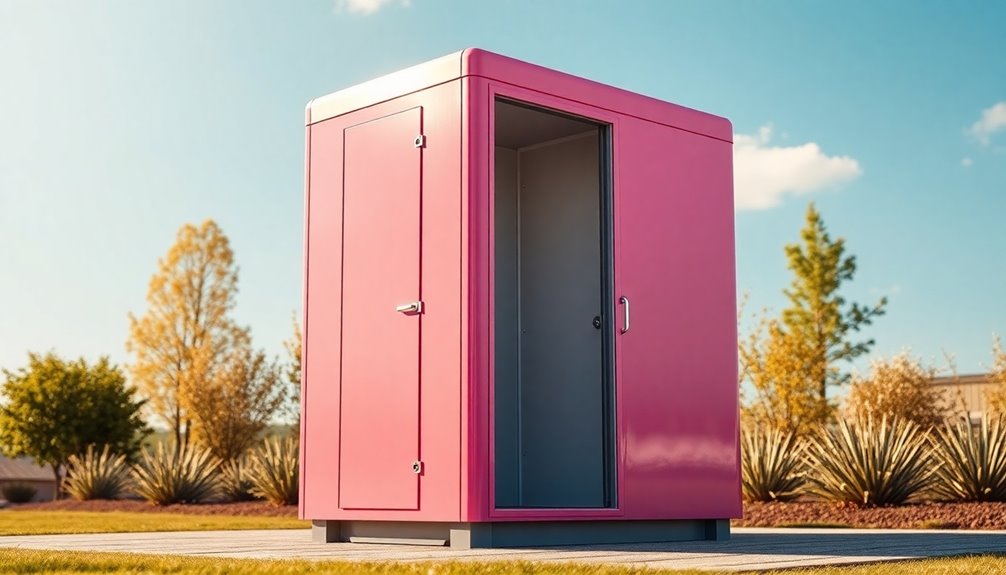
Composite materials in portable toilets offer a range of advantages that considerably enhance their functionality and appeal.
These lightweight materials make transportation and installation easier, potentially cutting logistics costs by up to 30%.
You'll also appreciate the superior durability and weather resistance, which can extend the lifespan of portable restrooms by 20-30%.
Improved insulation properties lead to greater user comfort, especially in extreme weather conditions.
Plus, the flexibility of composite construction allows for aesthetically pleasing designs, making it possible to customize units to match event themes or personal preferences.
Many of these materials are recyclable or made from recycled content, aligning with your sustainability goals and reducing the overall environmental impact of portable restroom production.
Enhancing Durability and Weather Resistance

When choosing a portable restroom, you want a unit that can withstand the elements and frequent use without compromising performance. Advanced composites markedly enhance durability and weather resistance, extending the lifespan of portable restrooms by up to 50%. Materials like fiberglass-reinforced plastics offer superior protection against UV rays and extreme temperatures, maintaining structural integrity.
| Material Type | Benefits | Impact on Maintenance Costs |
|---|---|---|
| Advanced Composites | Enhanced durability | Lower maintenance costs |
| Fiberglass-Reinforced Plastics | Superior weather resistance | Reduced repairs |
| Impact-Resistant Composites | Protection from vandalism and damage | Minimal downtime |
| Weather-Resistant Coatings | Repels water, resists mold growth | Easier cleaning |
| Lightweight Design | Easier transportation and setup | Lower transport costs |
These innovations guarantee your portable restroom remains clean and functional in any setting.
Lightweight Design for Improved Transportation
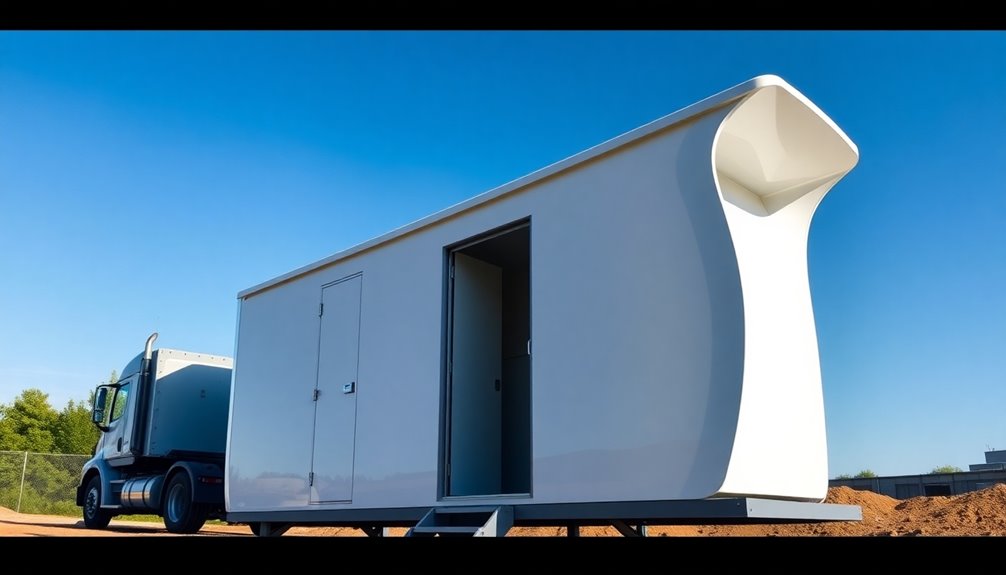
Lightweight design revolutionizes the transportation of portable restrooms, making it easier than ever to deliver and set up units at various locations.
By utilizing advanced composite materials, manufacturers reduce the weight of restrooms by up to 30%, greatly boosting transportation efficiency and lowering fuel costs.
These lightweight designs enhance maneuverability on construction sites and events, allowing for quicker setup and takedown.
Additionally, the durability of new materials like fiberglass-reinforced plastics means you'll face lower maintenance costs and enjoy longer-lasting products.
This shift toward lightweight designs also enables compact storage solutions, maximizing space in transportation and storage facilities when units aren't in use.
Eco-Friendly Aspects of New Composite Materials
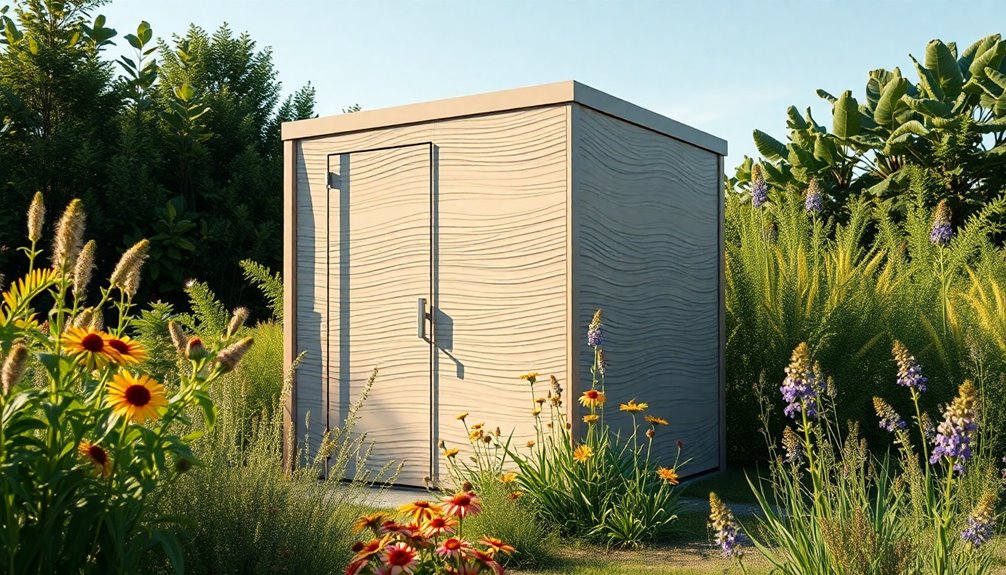
As the demand for environmentally friendly solutions grows, the introduction of new composite materials in portable restroom design offers promising eco-friendly benefits. Manufacturers are increasingly turning to ecofriendly materials in restroom design, utilizing recycled plastics and sustainable composites that minimize environmental impact. These innovations not only enhance the aesthetic appeal of portable restrooms but also contribute to reducing waste and carbon footprints. As a result, event organizers and facility managers are more inclined to choose options that align with their sustainability goals, fostering a more environmentally conscious approach in public services.
By incorporating recycled plastics, these materials greatly reduce the carbon footprint associated with production and disposal. Biodegradable materials also play an essential role, breaking down naturally and minimizing long-term environmental impact.
Additionally, some composites feature antimicrobial properties, enhancing hygiene while reducing the need for harsh chemical cleaners. Lightweight composite materials improve portability, leading to lower fuel consumption during transportation.
Finally, integrating renewable energy sources, like solar panels, allows these restrooms to operate with minimal reliance on conventional energy, addressing various environmental issues.
Together, these innovations represent a notable step toward sustainable restroom solutions.
Recyclability and Sustainable Practices

The advancements in eco-friendly composite materials not only improve the environmental footprint of portable restrooms but also enhance their recyclability and support sustainable practices.
By using recycled plastic, manufacturers greatly reduce the demand for virgin materials, lowering production's environmental impact. Innovative composites, including bio-based materials, are designed to be repurposed at the end of their lifecycle, making waste management practices more effective.
Many modern restrooms feature modular components that can be easily disassembled, promoting the recycling of individual parts. Additionally, sustainable manufacturing practices, such as eco-friendly adhesives and coatings, minimize harmful emissions.
With a growing emphasis on lifecycle assessments, sustainability considerations are now integrated from design to disposal, ensuring that portable restrooms contribute positively to the environment.
Innovations in Manufacturing Processes

While traditional manufacturing methods have served the portable restroom industry for years, recent innovations are transforming how these units are produced.
Advanced 3D printing technology lets you rapidly prototype and customize designs, cutting down production time and material waste. Manufacturers are increasingly turning to recycled plastics and bio-composites, creating lightweight yet durable restroom structures that enhance sustainability.
Innovative injection molding techniques allow for seamless designs, improving hygiene by eliminating crevices where dirt can hide.
Vacuum-forming methods enable the crafting of complex shapes with minimal material, boosting efficiency.
Finally, enhanced curing processes for composite materials lead to quicker set times and improved structural integrity, resulting in portable restrooms that last longer and withstand more wear and tear.
Cost-Effectiveness of Advanced Materials

When you consider portable restroom design, advanced composite materials offer significant cost savings.
By reducing manufacturing costs by up to 30% and extending the lifespan of units by 50%, these innovations make a compelling case for their use.
Not only do they save money upfront, but their durability also minimizes long-term maintenance expenses.
Reduced Manufacturing Costs
As manufacturers embrace advanced composite materials, they're finding significant reductions in manufacturing costs that directly benefit portable restroom design.
These innovative materials not only lower production expenses but also enhance efficiency. Here are a few key advantages:
- Reduced Weight: Lightweight materials decrease transportation expenses, allowing more units to be shipped at once and optimizing logistics.
- Faster Production: By cutting production time by up to 30%, rental companies enjoy quicker turnaround, reducing overall operational costs.
- Lower Maintenance: Durable composites often require less upkeep due to their corrosion resistance, leading to lower long-term expenditures for operators.
Long-Term Durability Benefits
Advanced composite materials revolutionize portable restroom design by offering exceptional long-term durability, which greatly cuts down on repair and replacement needs.
These innovative materials provide superior resistance to weathering, UV degradation, and corrosion, often lasting over 15 years. This longevity considerably reduces lifecycle costs, allowing you to save on maintenance and replacement expenses.
Additionally, their lightweight nature simplifies transportation and setup, minimizing fuel consumption and labor costs during installation. Many advanced composites require low maintenance, further lowering operational costs over time.
Although the initial investment might be higher, the long-term savings in maintenance and operational efficiency make advanced composite portable restrooms a cost-effective choice for any organization looking to enhance their facilities. Furthermore, using renewable resources in the manufacturing of these materials aligns with eco-friendly practices, promoting sustainability in design.
User Experience Improvements With Modern Designs

Modern portable restrooms are transforming the way you experience outdoor events with their enhanced ventilation systems, spacious interiors, and touchless operation features.
You'll notice a significant reduction in odors and improved airflow, making your time inside much more comfortable.
Plus, with features designed for easy access and hygiene, using these restrooms isn't just convenient but also a pleasant experience overall.
Enhanced Ventilation Systems
While using a portable restroom, you're likely to notice the significant improvements in air quality and comfort thanks to enhanced ventilation systems.
These modern designs prioritize user comfort and cleanliness, meeting public demand for improved sanitation experiences.
Here are three key features that elevate your experience:
- Exhaust Fans and Vents: Advanced models include exhaust fans and strategically placed vents for better airflow and temperature control.
- Natural Light: Larger windows and skylights enhance ventilation and create a more inviting space.
- Air Purification: Integrated air purification technologies actively reduce airborne contaminants, ensuring improved air quality.
With these enhancements, portable restrooms now offer a cleaner, fresher environment that makes your experience much more pleasant.
Touchless Operation Features
As you step into a portable restroom equipped with enhanced ventilation systems, you'll likely notice another significant improvement: touchless operation features.
These modern amenities, including automatic flushing systems and sensor-activated soap dispensers, drastically enhance user hygiene by minimizing contact with surfaces. Hands-free faucets and dryers streamline the handwashing process, ensuring a seamless and sanitary experience without touching potentially contaminated handles.
By integrating touchless technology, sanitation facilities not only promote cleanliness but also meet the growing expectations for convenience. Studies show that restrooms with touchless features reduce the spread of germs, contributing to healthier environments at events and construction sites.
User satisfaction ratings for these models consistently outperform traditional ones, highlighting a strong preference for enhanced hygiene and ease of use.
Spacious Interior Designs
When you step inside a portable restroom designed with spacious interiors, you'll immediately notice the difference in mobility and comfort.
These modern units prioritize user needs, making them ideal for construction sites and events.
Here are three key features you can expect:
- Larger Interior Space: Advanced composites allow for lighter structures, creating more room without sacrificing durability.
- Improved Ventilation: Enhanced airflow systems guarantee better air quality, making your experience more pleasant.
- Thoughtful Design Features: Higher ceilings and wider doorways accommodate everyone, including those with disabilities.
These innovations transform portable toilets into welcoming spaces, considerably reducing feelings of claustrophobia and enhancing overall user experience. Additionally, understanding the importance of proper planning in design can lead to more efficient use and maintenance of these facilities.
The Future of Portable Restroom Technology and Materials

Portable restroom technology is on the brink of a significant transformation, driven by innovative materials and design concepts that enhance functionality and user experience.
The integration of lightweight composite structures, like fiberglass and resin-infused materials, makes portable toilets easier to transport and set up at various events.
By using sustainable materials, such as recycled plastics, these units support eco-friendly practices while meeting the growing demand for green sanitation solutions.
Innovations in antimicrobial coatings improve hygiene, reducing bacteria growth and making cleaning a breeze.
Future designs will likely feature customizable layouts, allowing for greater adaptability to diverse needs.
Frequently Asked Questions
What Is the Future of Portable Toilets?
The future of portable toilets is looking bright and innovative.
You'll notice advancements in design that focus on user experience, with features that enhance hygiene and convenience.
Expect to see eco-friendly options gaining popularity, like biodegradable materials and waterless systems.
Smart technology will make maintenance easier, and customizable configurations will cater to various events.
As sustainability becomes a priority, portable toilets will evolve to meet your needs while minimizing their environmental impact.
What Material Is Used for Portable Toilets?
Most portable toilets are made from high-density polyethylene (HDPE). This material's lightweight and durable, making it ideal for transport.
You'll notice the molded design adds strength while keeping the overall weight down. Some manufacturers are also exploring recycled plastics for sustainability, which helps reduce environmental impact.
Additionally, advancements in material science are introducing antimicrobial coatings, enhancing hygiene and minimizing bacteria growth, making your experience in portable restrooms more pleasant.
What Materials Are Used to Build a Portable Toilet?
Imagine if portable toilets were made of wood like in the olden days!
Nowadays, they're primarily built from high-density polyethylene (HDPE), which is lightweight and super durable. Many units also use recycled plastics, making them eco-friendly.
Some luxury models incorporate fiberglass for added strength and smooth cleaning surfaces. Plus, advanced composites and antimicrobial coatings are becoming popular, enhancing durability and hygiene.
You'll really appreciate these innovations next time you need one!
What Materials Are Porta Potties Made Of?
Porta potties are mainly made from high-density polyethylene (HDPE), a tough plastic that resists impact, UV rays, and corrosion.
You'll find that many modern designs incorporate composite materials, blending plastics with fiberglass to enhance strength while keeping them lightweight for easy transport.
Additionally, the interiors often feature anti-bacterial coatings for better hygiene.
Some manufacturers even use recycled materials, promoting sustainability while ensuring durability and functionality in various environments.
Conclusion
In the ever-evolving world of portable restrooms, new composite materials are like a refreshing change, transforming the industry with unmatched durability and eco-friendly benefits. These innovations not only lighten the load for transportation but also enhance your overall experience. As we look ahead, expect portable toilets to blossom into sleek, resilient designs that cater to your needs while respecting the planet. The future's bright, and it's paving the way for a cleaner, more comfortable restroom experience.


